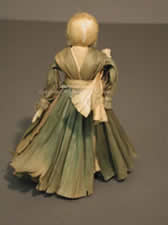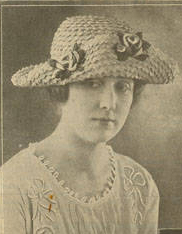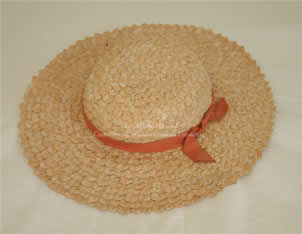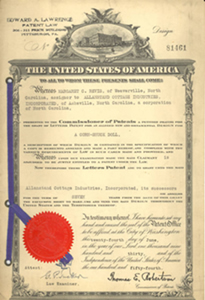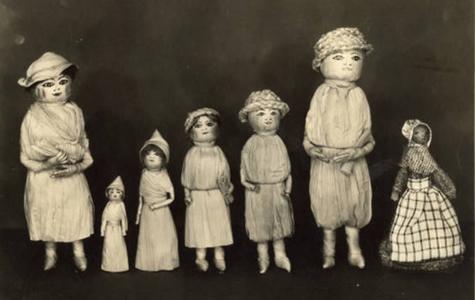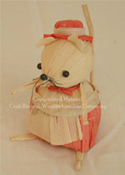Cornhusk crafts
While most people are familiar with corn's importance as a foodstuff, the cornhusk, a byproduct, has been useful as well. With an abundance of corn grown on the region's farms, Appalachian people developed a particular fondness for the material, especially for the making of dolls. While not unique to the Appalachian region, cornhusk (or corn shuck) dolls and crafts enjoyed a special popularity that reached its peak during the Craft Revival period in the early 20th century. Despite the lasting appeal of cornhusk dolls, hats, bags, and other cornhusk arts, comparatively little is known about the origins of the craft.
The earliest examples of cornhusk dolls were made by Native Americans. While most tribes used the dolls as toys for children, the Iroquois and Oneida tribes incorporated cornhusk dolls into their religious practices. It is not known if Native Americans taught Colonial Americans the craft, or if the practice developed in parallel, but cornhusk dolls were made by European settlers and by African slaves. All three groups used the same basic technique to craft the dolls. The outer wrapping of the corn cob, the husk, was soaked until it could be shaped and then dried to create the desired form. 1 During the Craft Revival, doll makers in the region began experimenting with shapes and designs to broaden the dolls appeal to perspective buyers; many continued to produce other types of cornhusk art as well, particularly hats.
As with dolls, the Craft Revival witnessed the growth in popularity of cornhusk hats. Produced in a similar fashion to dolls, to make a hat, the husks were dried, dyed and then soaked to make pliable strands that were cut into ½ inch strips and braided. During the Craft Revival, the variety and styles of cornhusk hats grew to meet the desires of the growing number of tourists visiting the southern Appalachians. Among the styles of hats produced were traditional wide-brimmed hats, decorative women's hats, and sunshade visors. 2
During the Craft Revival period, the popularity of cornhusk dolls and crafts grew due to the craft's availability. Allanstand Craft Shop in Asheville, and later the Southern Highland Handicraft Guild, featured the works of many western North Carolina doll makers, including Margaret C. Revis of Weaverville, Frances Nicholson from Jackson County, and May Ritchie Deschamps from Swannanoa. Revis and Allanstand Cottage Industries submitted a successful patent for her doll design. The patented family of dolls with folksy names, such as Tiny Tot and Maizie, helped popularize the craft. 3 While Revis and the Allanstand Craft Shop contributed to the growth of the cornhusk craft, Nicholson and Deschamps helped to further evolve the styles and techniques of the form.
Frances Nicholson, who was born in 1897 and produced cornhusk art until her death in 1990, is considered one of the most innovative cornhusk artists of the Craft Revival, earning the nickname "Corn Shuck Queen" of North Carolina. 4 As the Craft Revival evolved, so did its terminology. Today's term "cornshuck" eventually eclipsed the earlier "cornhusk," although both terms are used. Nicholson made traditional human-shaped dolls and animals such as mice and horses. Nicholson's hats reflected a wide range of styles and incorporated contemporary fashion elements into their designs. Self taught, Nicholson developed her own unique methods of working with cornhusk, which she passed along to many students through programs such as the National Youth Administration.
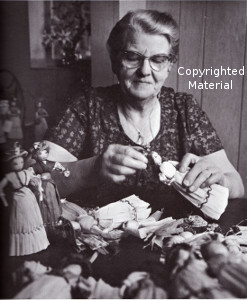
Like Nicholson, May Ritchie Deschamps was an important innovator of cornhusk crafts. Born in Clear Creek, Kentucky, Deschamps learned cornhusk doll making from her family and at the Pine Mountain Settlement School where she was a student and later a teacher. In 1936 May Ritchie married Leon Deschamps, a forester and teacher at the John C. Campbell Folk School in Brasstown, North Carolina. 5 She began producing and selling dolls. Responding to the needs of her customers for a more durable doll, Deschamps experimented with materials. An example of a more commercially friendly design can be seen in the materials of her doll's hair; Deschamps switched from the traditional use of corn silk to a more hearty jute. Such changes, dictated by economic factors and sales appeal, were common to the movement.
From dolls to hats, the development of cornhusk crafts during the Craft Revival exemplifies the movement's core emphasis on quality and individual artistic design, while remaining faithful to the genre's traditions. Tourists who sought out traditional crafts fueled a demand for a variety of new cornhusk styles. Craft Revival pioneers, such as Revis, Nicholson, and Deschamps, were eager to satisfy that demand and helped to innovate and market a folk tradition, establishing a commercial craft form that remains popular to this day.
Jason Woolf, 2009
1. "Early American Cornhusk Doll Kit,"Historical Folk Toys. [online] http://www.historicalfolktoys.com/catcont/4710.html#more; Internet accessed 14 April, 2009. Alison Burke. "Remnants of a Lost Era: Appalachian Primitive Dolls." Alabama Heritage: Fall 2003. [online] http://findarticles.com/p/articles/mi_qa4113/is_200310/ai_n9255656/ Internet accessed 14 April, 2009.
2. Harriet Cushman Wilkie, "Clever Corn Shuck Tricks," Unidentified newspaper in the collection of the Southern Highland Craft Guild.
3. Design for a Corn-Shuck Doll, by Margaret C. Revis (June 24, 1930), Patent Des. 81,461 in the collection of the Southern Highland Craft Guild. "Woman of the Week," Sylva Herald (February 20 1961).
4. "The Dolls of May Ritchie Deschamps," [unpublished document] 1981, in the collection of the Southern Highland Craft Guild.
5. John C. Campbell Folk School 19 [school newsletter] (May 1936).
